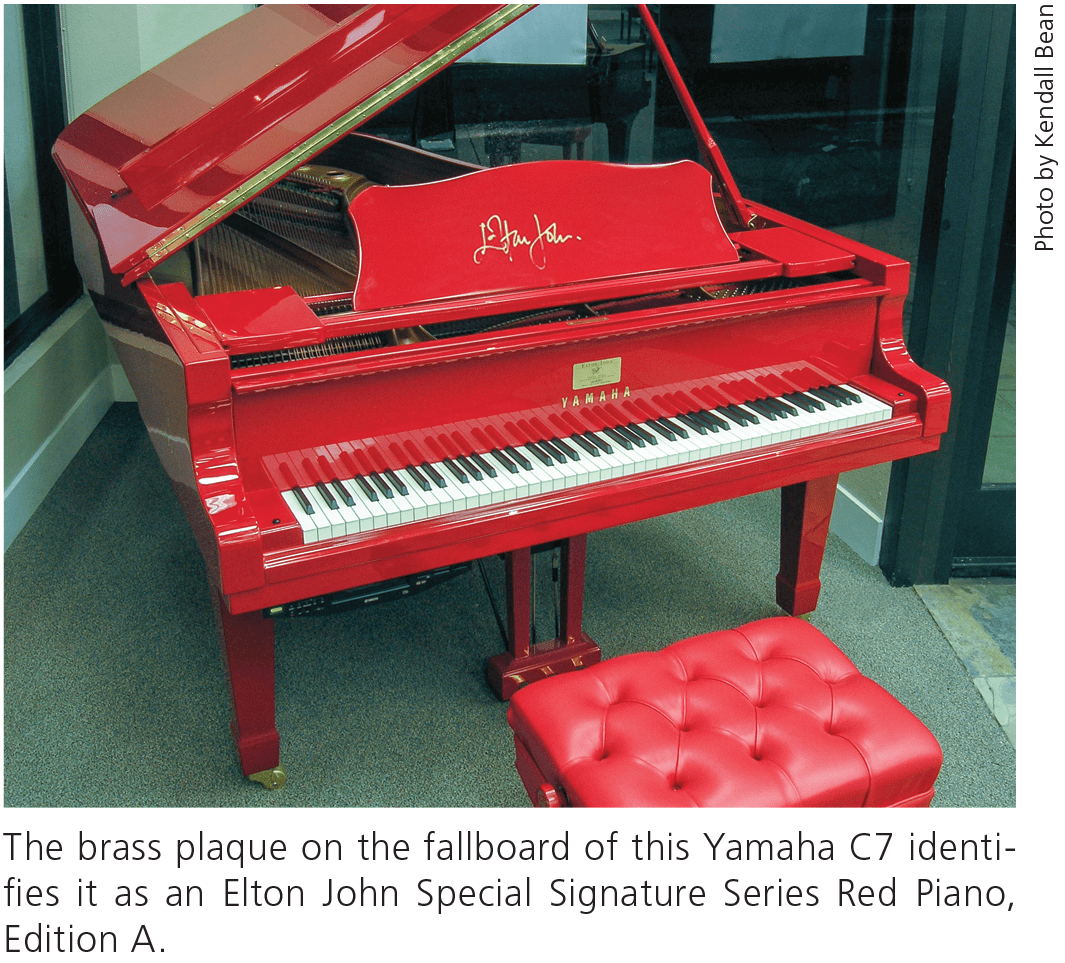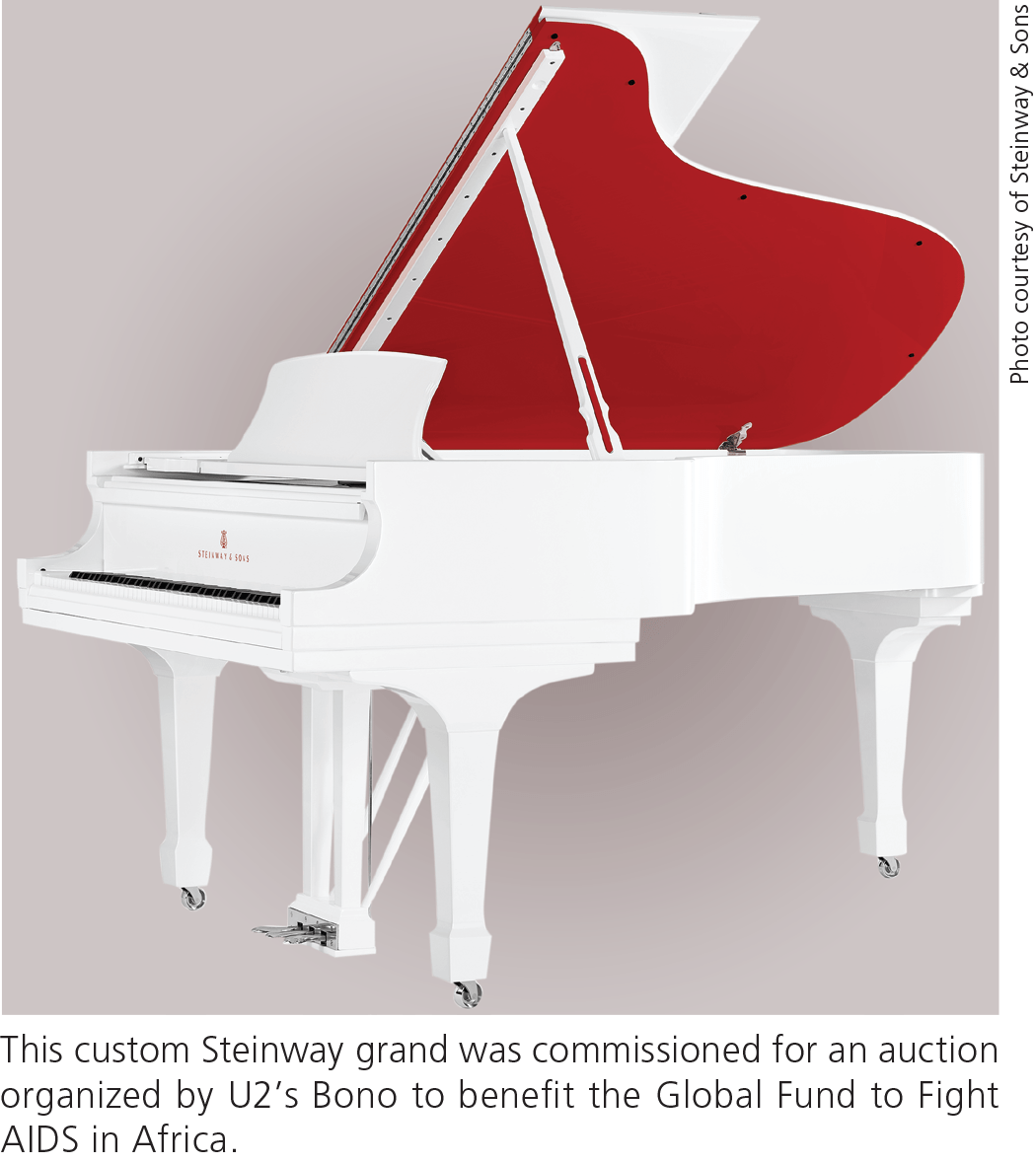Courtesy of Acoustic and Digital Piano Buyer
The Private and Public Sides of Celebrity Pianos by Karen E. Lile. Acoustic and Digital Piano Buyer Spring 2018
Many aspects of a celebrity’s life, and the lives of their families and friends, are constantly under examination by the public. Privacy is a precious commodity, and they strive to preserve it wherever possible. Being the niece of an introverted music celebrity who performed and recorded with a continuous stream of other celebrities throughout his Hollywood career of more than forty years, I understand the private side of celebrities.
My History
My uncle, Tony Terran (1926–2017), was a trumpet player who began his long career in 1946 as a member of the Desi Arnaz Orchestra, and played with Desi on the I Love Lucy television show from its debut in 1951 until the final episode in 1961. During the 1960s, he was also part of the famed Los Angeles–based group of studio musicians known as the Wrecking Crew. Tony played with a huge variety of celebrity musicians in film soundtracks, on the concert stage, and in recording studios. The musicians who knew him don’t list the thousands of albums in which he was featured; they just keep it simple and say that Tony played with “everyone,” from Frank Sinatra to Michael Jackson. Uncle Tony took me behind the scenes in Hollywood in my early 20s, giving me advice about the industry and teaching me, among other things, to value privacy and keep confidences.
I became involved in the piano business because I loved piano music and was intrigued with the music-products industry. In my early 20s, I encountered a talented business partner, Kendall Ross Bean. Kendall was halfway through a doctoral-degree program in piano performance, and I was finishing up my degree in English. A combination of his skills in piano rebuilding and historical documentation, and my creative business sense, resulted in our establishing Piano Finders, a rebuilder of high-quality pianos, in the San Francisco Bay area. Both of us being socially skilled introverts with an analytical approach, we attracted a clientele that eventually led us into appraising celebrity pianos. Our approach was to support any subjective opinion we had with facts, measurements, and objective documentation. By revealing why we had reached our conclusions, we gave our clients an opportunity to decide for themselves on the occasions when other experts’ opinions differed from ours. Our appraisal work was also noticed by others, and due to our analytical approach, interior decorators, banks, insurance companies, attorneys, art buyers, estate appraisers, and dealers in antiques and musical instruments began hiring us to appraise pianos for various purposes. Over time, we documented and appraised more than 3,400 pianos, including many with celebrity value.
How Celebrities Can Add Value to an Instrument
Celebrities can add value to a piano in a variety of ways, including:
- Owning a piano
- Performing on a piano, either once or over a period of time
- Composing on a piano
- Signing a piano
- Collaborating with a manufacturer on the design of a piano
- Auctioning a piano for the benefit of a charity or nonprofit
Pianos Owned by Celebrities
Celebrities can add value to pianos just by owning them, even if they don’t play the pianos themselves and/or have no intention of selling them. When Kendall and I were in our 20s and still developing our methods for appraising celebrity pianos, one of our early clients was Larry Ellison, co-founder and CEO of Oracle Corporation. Ellison was then building his home in Woodside, California, and his private art buyer, Glenda Martin, commissioned our company to find Ellison two fine-quality vintage grands and rebuild them for two of his spaces. The pianos Ellison had Martin purchase were for his own personal pleasure and business use; Martin told us that Ellison had no intention of reselling them. One of the pianos became part of the Woodside residence, whose value is now estimated at $70 million; the interior designer placed the instrument in a beautiful room designed around it. The other piano is located in a commercial space, to be used for business entertaining.
The appraisals we performed were first for purchase, and later, after the pianos were rebuilt, for insurance purposes. In the second appraisal, we didn’t take into account the pianos’ celebrity value, as Ellison didn’t intend to resell them. Now, more than 20 years later, the pianos have acquired history, having been owned by someone of great renown who placed them in prominent and luxurious settings, and having had many artists entertain on them. If Ellison or his estate were ever to decide to sell or donate the instruments separately from the rest of the property, they could be revalued to reflect that history. This example illustrates that celebrity value can change over time, and that, while ownership by a celebrity often adds value to an instrument, whether or not that value is taken into account in a particular appraisal will depend on the purpose for which the appraisal is written.
More commonly, the death of a celebrity, and the disposition or probate of his or her estate, results in an appraisal. Although the facts of the marketplace dictate the value that an appraiser places on an instrument, in my conversations with the family members of the recently departed I often listen with empathy to their feelings, then explain what type of appraisal they need for the purposes they contemplate. For example, when Gloria May, the daughter of film star Ann Rutherford (Carreen O’Hara in Gone with the Wind), contacted me after her mother’s death to discuss her mother’s piano—a Boston-made Mason & Hamlin grand—we talked about the piano’s celebrity value. I asked her what had been important to her mother, and how she had lived her life. Gloria explained that she and her brother didn’t play the piano, but that it was a part of their private family life and the entertaining Rutherford did in her home, especially to benefit her favorite charities. May decided that she preferred to honor her mother by donating the piano to a nonprofit, and asked me to connect her with one, rather than to engage in the process of a public sale. She donated the piano, and we did an appraisal to help her in her decision-making process. May died a few years after making the donation, but I think she would have been delighted to know that the person in San Francisco who bought her piano from the nonprofit had it rebuilt by us, and now regularly hosts socials with pianists who perform on the instrument and talk about the life and accomplishments of Ann Rutherford, its previous owner.
Pianos Performed On by Celebrities
A celebrity can add value to a piano by performing on it, or by taking it on tour. A set designer for Julio Iglesias asked us to arrange for someone to create a specialty piano case for Iglesias’s tour of Spain, and we made arrangements with Baldwin to have this done. The piano was part of the touring set, and not intended for sale afterward. Had we appraised it for resale, however, we would have been justified in adding value for the custom case and the piano’s association with the Iglesias tour.
At Fantasy Studios, when Patrick Stewart (Star Trek: The Next Generation, X-Men) sat down at a piano just rebuilt by Piano Finders, he tweeted to his fans, “No, I don’t play, but Bill Evans did, and I’m at his piano, where he recorded—Fantasy Studios, Berkeley. Goosebumps.” Although the piano was not for sale, Stewart’s tweet indirectly added to its value by drawing his fans’ attention to the fact that it had been played by many famous musicians. For now, the piano has greater value to the studio as a fine working instrument that musicians appreciate recording on. Eventually, should Fantasy choose to sell this piano, we might find ourselves appraising the piano for its accumulated celebrity value, acquired from all the artists who have recorded on it over time.
Pianos Composed On by Celebrities
A celebrity can add value by composing on a piano. We have appraised pianos composed on by Dave Brubeck, George Winston, and other entertainment celebrities. Although we did not appraise the Steinway upright on which John Lennon composed “Imagine,” its sale at auction in 2009 for $2.37 million to another British rock star, George Michael, is a matter of public record, and gives you an idea of the sums that such pianos can, on rare occasion, bring.
The above examples illustrate how value can be added to a piano without the knowledge or intention of the owner or user. They may not care about their fame as it pertains to the piano, or are focused on their work at the piano rather than on the instrument’s value—the piano is simply a comfortable part of their personal or work life. Depending on the purpose for which an appraisal is written, the celebrity value may not be officially recognized until needed for the instrument’s sale or donation, often after the owner’s or user’s death.
In the examples that follow, on the other hand, the added value was not only intended, but was usually planned in great detail for the express purpose of increasing the piano’s value for the benefit of a charity or brand image. Although listed here separately, these different ways of adding value are often combined, such as when a piano is designed in collaboration with a celebrity, signed by the celebrity, and auctioned off for charity.
Pianos Signed by Celebrities
A celebrity’s signature on a piano can increase its value. For example, an attorney in a well-known court case in Florida hired Piano Finders to appraise a Yamaha piano that Elton John had signed as part of a limited-edition series. The owner had filed for bankruptcy, and the court recognized that the piano had celebrity value and asked us to appraise it.
Pianos Designed through Collaboration with a Celebrity

The above-mentioned instrument, a Disklavier-equipped Yamaha grand, was number 8 of 30 in the Elton John Limited Edition Signature Series Red Piano, designed by Yamaha as a tribute to Elton John. When Yamaha planned the Red Piano series, their respect for John led them to take great care in the marketing of the pianos, including special recorded performances by John provided exclusively to the instruments’ purchasers. When the series was released, Yamaha proclaimed, “Elton is the quintessential crown jewel of the Yamaha artist family. The new Elton John Signature Red Piano is our way of paying tribute to one of the greatest rock legends of all time.” A special relationship such as this between a manufacturer and a celebrity artist gives added value to a piano, especially when it’s part of a limited-edition series, where the demand is likely to be greater than the supply.
Pianos Auctioned for the Benefit of a Charity or Nonprofit
Celebrities often have favorite charities, and some have even set up their own. They contribute their celebrity status to help the charity by auctioning off personal items, including pianos, for thousands or, rarely, even millions of dollars. Celebrities deliberately create added value for pianos by performing on them, signing them, and/or endorsing a piano brand.
When a sale is planned for the piano of a celebrity with high social and cultural status, multiple entities can be involved in the planning, both before and after the event, each with its own intellectual-property territories. Examples include television broadcast companies, artist management companies, auction or special-events production teams, film producers, and one or more nonprofit organizations. If we’re asked to appraise a celebrity piano during the planning stage of such a sale, we often also serve as a consultant on historical documentation. I may fly to a corporate headquarters and talk to key people to discuss the history of the piano, while Kendall may be flown to the piano’s location, where he documents its condition and any custom technical modifications made for the celebrity. In these situations, we are generally required to sign a nondisclosure agreement early in the process. When we begin the appraisal, we don’t know the outcome. I’ve witnessed situations in which a piano I appraised was initially intended for a public sale, but during the process the parties involved decided to keep the sale private.

Unlike auctions for serious collectors, charity auctions are emotional affairs. That is, those who participate in a charity auction are not bidding huge sums for an instrument’s carefully appraised musical or historical value. Rather, wealthy potential buyers may bid unusually high amounts because they desire to benefit the charity, enjoy competition with their peers, and find the auction process exciting. For example, a custom red and white Steinway grand commissioned for a star-studded (Red) auction organized by U2’s Bono to benefit The Global Fund to Fight AIDS in Africa, sold for $1.925 million to billionaire philanthropist Stewart J. Rahr. Nevertheless, auction prices can set a precedent for the value of an instrument; such precedents then become part of the comparisons that appraisers consider when appraising another piano associated with that celebrity, or with a celebrity of similar status.
There are nuances to the amount of celebrity value a piano acquires, based on the type of celebrity interaction with the instrument in question. For example, an Elton John Signature Series Red Piano that contains an exclusive recording of Elton John performances that can be played back on a Disklavier would not be considered as valuable as a piano actually owned by John and used for a majority of his practice and composition. So, while the piano that John Lennon used to compose “Imagine” was purchased at auction for $2.37 million, no Red Piano that Elton John has not personally played has yet commanded (on public record, at least) anywhere near as high a price.
It’s important to emphasize here what should be obvious: Simply stating an appraised value doesn’t create or guarantee that value. A piano is worth only what a buyer and seller agree on, what members of a family negotiate with one another in the settlement of an estate, what a court decides in a bankruptcy or divorce, or what an insurance company pays in the event of a loss. An appraisal is only an estimate of what that value might be, and not always an accurate one. That said, examining years of our own appraisal data, we find that, outside of charity auctions and other highly publicized sales, the value added to a piano from association with a celebrity typically ranges from $50,000 to $1,000,000. However, an amount outside this range, higher or lower, is entirely possible, depending on the strength of the celebrity’s status, the nature of his or her association with the piano, and other factors.
How Fans Can Contribute to Celebrity Value
Fans are interested in the talents, lifestyles, and personal lives of film stars, entertainers, and celebrities of all kinds, and the success of a celebrity’s career depends upon a devoted following. Fans will come to a film, concert, or just about any other event a celebrity is associated with, just because of the celebrity’s participation. And the celebrity’s name can have value to others as well—those who know that the celebrity has made a commitment to do something even before he or she has done it. For example, based solely on a film star’s name, a producer can get a larger loan for the production of a new film.
But even more than fame, fans admire a musician’s skill, and how his or her music moves them emotionally. We have stories, from as early as the 1800s, about virtuoso pianists, such as Liszt and Chopin, becoming the “rock stars” of their day. Liszt “transfixed audiences with his unique combination of charisma, dashing looks and Herculean pianistic skill. He exploited this part to the fullest and sent the ladies wild; they wrestled each other to get close to the stage, some fought tooth and nail over discarded gloves or cigar stubs, others simply fainted.” (All Things Considered, NPR, “How Franz Liszt became the world’s first rock star,” Oct 22, 2011.) During the late 19th and early 20th centuries, when a rise in prosperity created legions of piano buyers in Europe and America, the emblems of royalty affixed to the piano soundboards held appeal for the upper middle-class buyers, who trusted the piano brands endorsed by Europe’s royal families. Similarly, piano manufacturers solicited the endorsements of famous pianists, who were sent on concert tours to promote the manufacturers’ instruments.
But it wasn’t until the 1950s, when fan mania of all kinds (rock ’n roll, film, sports, etc.) and mass-media marketing combined to create the climate of public celebrity we know today. Teams of marketing specialists and venture capitalists who invested in the names of the celebrities they promoted used their combined skills of production, marketing, and mass-media manipulation to amplify their celebrity clients’ skills and charisma.
This mania was facilitated in part by state laws, and by court decisions beginning with Haelan Laboratories, Inc. v. Topps Chewing Gum, Inc., a 1953 decision of the U.S. Circuit Court of Appeals for the Second Circuit, that gave celebrities a “right of publicity” in the commercial use of their image and name. (The case in question gave baseball players the ability to prevent the unauthorized use of their images on trading cards packaged with bubble gum.) This right gave the famous—and, perhaps more important, those who manage or invest in them—an incentive to monetize their celebrity status and engage in behavior that builds fan bases. In fact, it has been noted that this right has developed in such a way that monetization is not only expected of the famous, but is virtually demanded of them by their investors, who expect to make a profit on their investment.
Documentation Required to Prove Celebrity Value
As the money to be made from celebrity status has increased, so have the clever ways to fraudulently claim association with celebrities. For that reason, just as a fine-art appraiser must have proof of a painting’s provenance, a good personal-property or piano appraiser will not take celebrity value into consideration unless it has been carefully documented. Such documentation can take a number of forms, including:
- Transport records of when a piano was moved to and from a significant event
- A photograph of a celebrity’s signature on the cast-iron plate, music rack, or other part of the piano
- Photographs or films of the piano documenting a celebrity performing on it
- A technician’s inspection report documenting special changes made to the piano for a celebrity pianist’s playing technique or preference
- Written statements by the celebrity about the piano, clearly identifying the piano by serial number, or in some way that can be proven by other supporting documents
- Testaments of credible witnesses as to a specific piece of history or story associated with the celebrity’s involvement with the piano
- Authorized manufacturers’ statements as to a celebrity endorsement or relationship
How Celebrities Add to the Piano’s Social History
Pianos are truly amazing instruments, not only for the music that can be produced through them, but also for the social, cultural, and symbolic history surrounding them. Celebrity association has always been part of the latter. Whether a celebrity’s involvement with a piano is known to the public, or to only a few people in a private transaction, people care about that history. Celebrities add value to pianos, not only from association with their name, but because the stories we tell and hear about them add interest to our lives and to an understanding of our shared popular culture.
We can also pay tribute to the courage it takes to be in the public spotlight, and to the extent we are all enriched by the talents and contributions of celebrity performers. When a celebrity is generous enough to add value to a piano, many people benefit: the manufacturer who made the piano, the dealers who sell pianos of that brand, the professionals who become involved in managing the artist’s intellectual and physical property, the charities that receive donations from a sale, and the fans who love the music and history that have been created with the instrument. It is to be hoped that such generosity will also inspire new artists to develop their talents of playing, composing, and performing at the piano, and will continue to add to the piano’s rich social history.

Since 1982, Karen Lile, co-Owner of Piano Finders, has appraised over 3,400 pianos for celebrities, lawyers, accountants, insurance adjusters, insurance companies, estate trustees, piano dealers, universities, buyers, sellers, owners, and nonprofit organizations. Her business partner, Kendall Ross Bean, holds a Master’s Degree in Piano Performance and is a master

